Caring for your Calathea zebrina (latin name) or Zebra plant (common name) calls for a good deal of care and attention based on my personal experience.
I made many mistakes in the beginning. In this article, I want to share what worked for me or, more importantly, my Calathea zebrina.
Calathea zebrina Plant
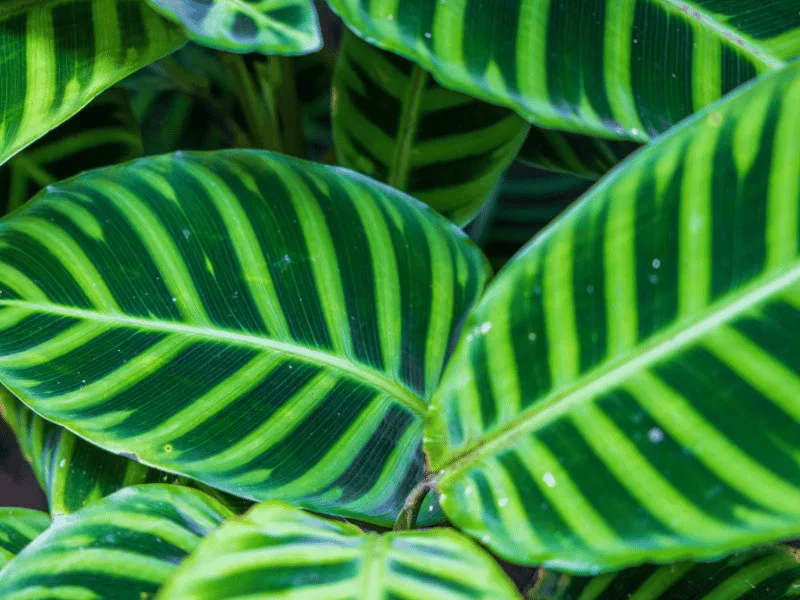
The Zebra plant, also known as Calathea zebrina is a lush foliage plant that sports large ovate leaves at the tips of long stalks.
The velvety patterned leaves with bright hues of green are marked with stripes that resemble the stripes on a zebra.
The leaves feature purple undersides, which are usually not visible due to the horizontal growth of the leaves.
However, one can see the lovely hue when some leaves grow upright or curve to some extent.
Takeaways
| Species | Calathea zebrina |
| Synonyms | No synonyms listed |
| Family | Marantaceae |
| Genus | Calathea |
| Growth | Upright, clumping |
| Height | 2.0 feet (approximately 61 cm) |
| Width | 2.0 feet (approximately 61 cm) |
| Soil | Well-draining potting mix |
| Watering | Every 7-14 days |
| Light | Bright indirect |
| Temperature | 65.0°F - 85.0°F (18.3°C - 29.4°C) |
| Humidity | 50% - 70% |
| Fertilizer | 7.0 |
| Propagation | Division or stem cuttings |
| Toxicity | Non-toxic to cats, dogs, and humans |
Calathea zebrina Care
To care for Calathea zebrina, provide a peat-based potting mix consisting of 2 parts peat and 1 part perlite. Provide it with a spot where the plant gets bright indirect sunlight. Water once a week on average and ensure the soil stays slightly moist. The ideal temperature range is 65 -85 °F (18-29°C). Keep the humidity at 60% and above, as this is a humidity-loving plant. Fertilize once every two weeks in spring and summer with a liquid fertilizer diluted to half-strength.
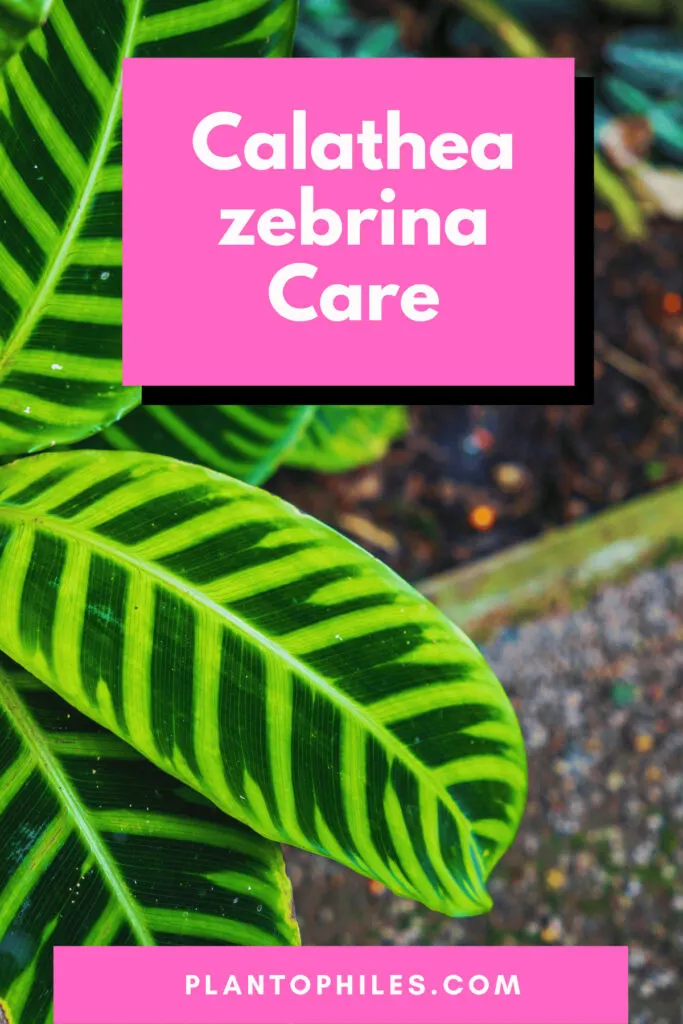
Table of Contents
What Soil is best for a Zebra Plant?
Calathea zebrina best grows in a peat-based potting mix. It’s best to use a combination of 2 parts peat and 1 part perlite—Zebra plants like rich, well-drained soil that holds moisture.
The simplest option is to use an African violet potting mix, or you can make your blend of one part garden soil, one part sand or perlite, and two parts peat moss or coir.
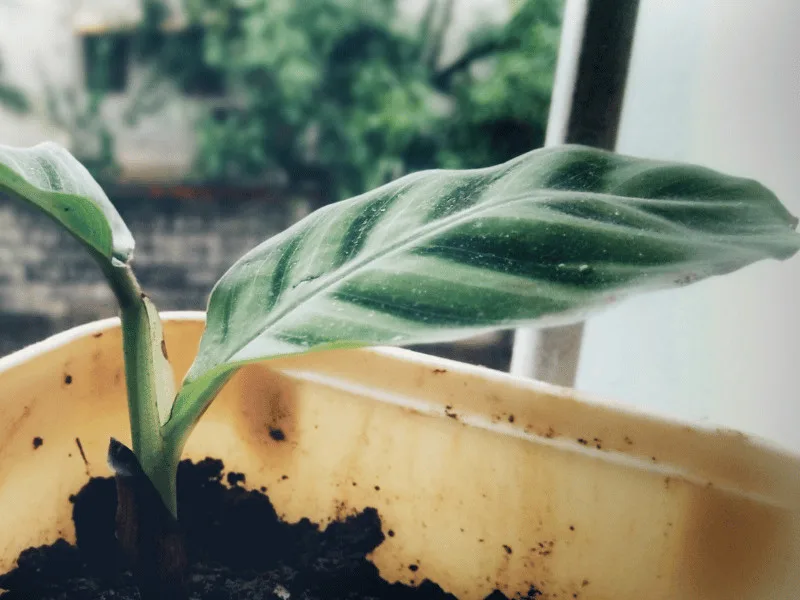
Calathea zebrina Light Requirements – Bright but not too Bright!
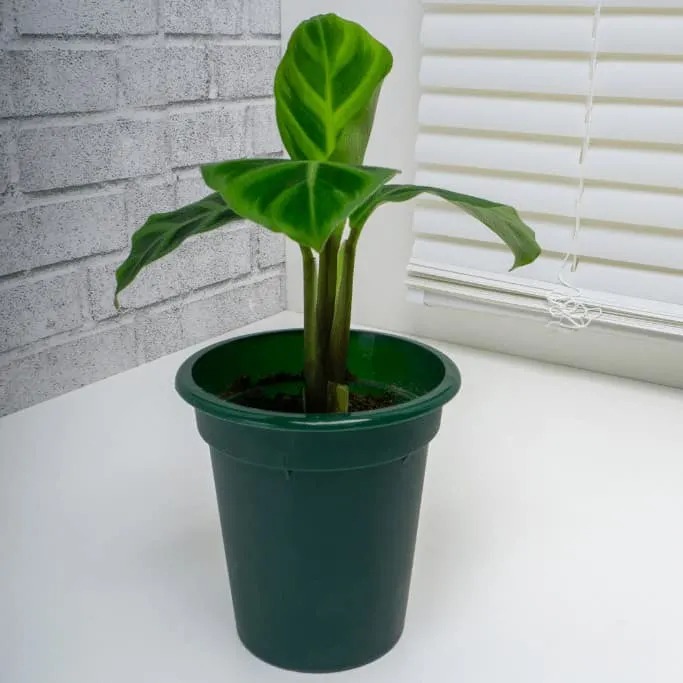
Calathea zebrina prefers a spot with nice bright, indirect sunlight.
According to the University of Florida, Calatheas should be growing using 1000-2000 foot candles of light.
Whether it’s excess of darkness or direct sunlight, Calathea zebrina calls for protection from both.
A great option is to place the plant somewhere where it’s treated with filtered bright light, preferably through a curtain.
The plant does well when placed in a north-facing window, while you must shield the plant from direct rays of the sun if going for some other setting.
Direct sunlight is fatal for the plant as it burns the leaves and makes it lose its bright hues.
Watering – Keep it Moist
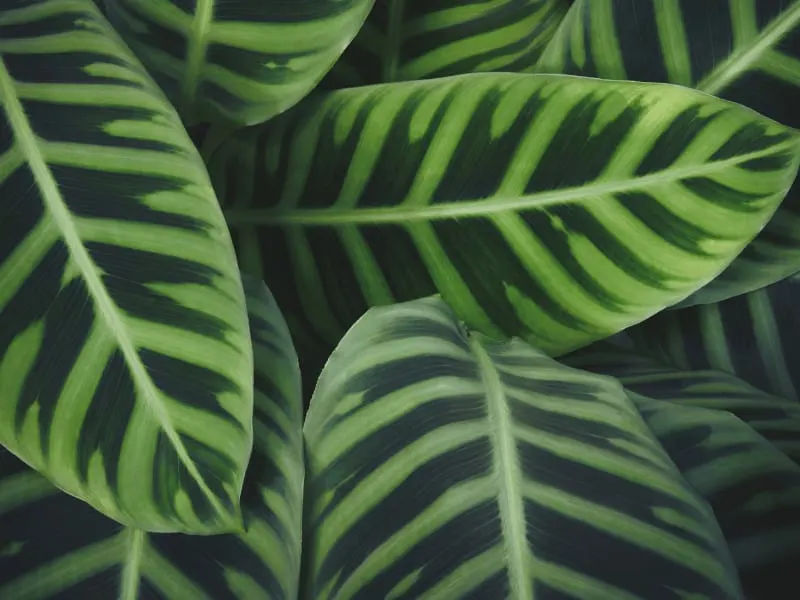
Water Calathea zebrina about once a week and ensure the soil stays moist but not soggy.
When the plant is in the growing season, it will call for loads of water.
A moisture-loving plant, Calathea zebrina needs wet soil to thrive.
But at the same time, you must make sure that the plant doesn’t sit in deep water.
Also, reduce watering during winter when the growth slows down or stops completely.
Between each watering session during winter, make sure you allow the soil to turn slightly dry.
Avoid cold or hard water for watering your zebra plant. Instead, go for tepid rain or distilled water.
Calathea zebrina must stay moist all the time but not completely wet.
So, keep the soil of your zebra plant pot moist yet draining well.
Temperature – Room Temperature is Just Right
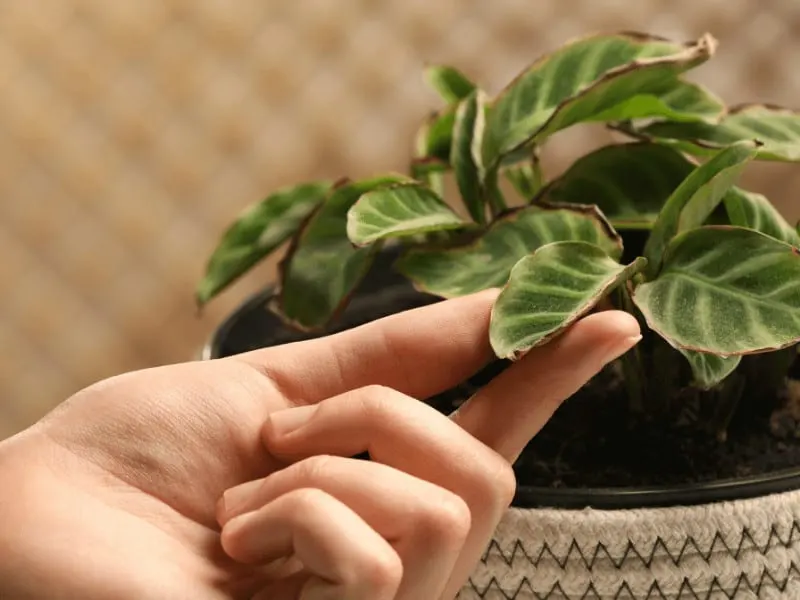
Zebra plants thrive best at average room temperatures that range from 65 -75 °F (18-24°C).
However, don’t place the plant in temperatures below 60 degrees Fahrenheit.
Another thing to ensure is to protect your Calathea zebrina from sudden temperature drops and cold drafts.
Also, protect your plant from drying and overheating by keeping it away from heating vents.
What is the Calathea zebrina Cold tolerance?
Calatheas are not cold-tolerant. The Zebrina plant needs an average room temperature. It starts to wilt and die below 50°F (10°C).
Humidity – Lots of it
Calathea zebrina prefers humidity levels of 60% and more. The ideal would be between 70-90%.
Humidity is one of the most important aspects of caring for your zebra plant.
Most people go wrong when maintaining the right humidity levels around their zebra plants.
Calathea zebrina calls for high humidity and to make sure to keep the soil adequately moist.
If that doesn’t work, you may provide the plant with more moisture by using a humidity tray or an electronic humidifier.
It’s also recommended to place your Calathea zebrina near other plants.
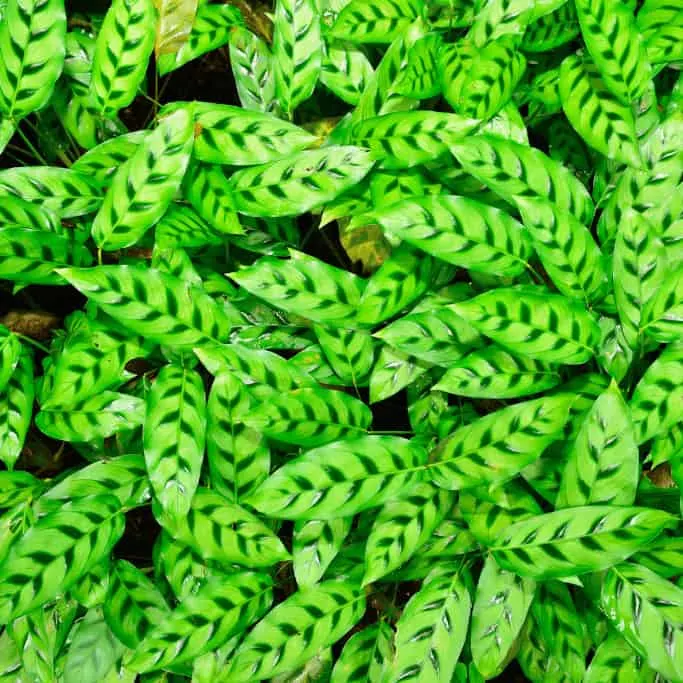
Fertilizer – Twice a Month
Feed your Calathea zebrina with a standard liquid houseplant fertilizer during the growing season in spring and summer once every two weeks, going for a half-strength fertilizer mixture.
Avoid using fertilizers during the winter season.
How Fast and Tall does Calathea zebrina Grow?
Calathea zebrina has quite a fast growth rate, especially if you use a good soil mix and feed the plant every week. It grows up to 2 feet in height.
Although the zebra plant grows quickly, it doesn’t grow and spread out on the pots.
This plant usually only grows up to an average of 2 feet in height and then takes a halt.
Zebra plant yields long stalks that grow up to 3 inches in height. The fact that it forms small clumps makes the plant leaves grow at the very top of the stalks.
Potting Up your Calathea
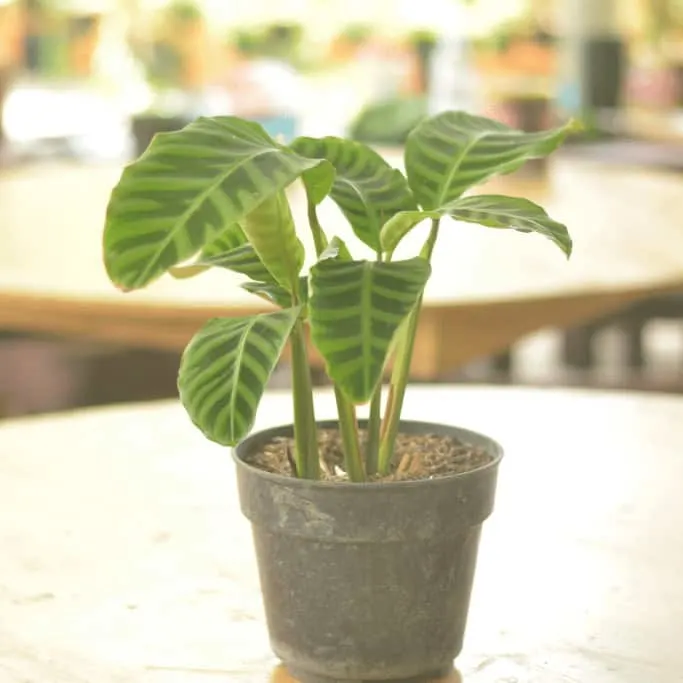
You can re-pot your healthy Calathea zebrina semi-annually or annually during the summer and spring season while going for new potting soil.
To generate more plants, you can divide and replant them by division.
Although the young plants may not seem to be as lush and dense as the mother plant, the right care will make them get bright foliage over time.
The fact that Calathea zebrina proliferates is the reason behind the same.
Calathea zebrina Propagation
Calathea zebrina can be propagated by division. It is not possible to propagate Calathea zebrina from leaf or stem cuttings.
It’s almost effortless to grow new plants by dividing the plant once you are repotting it.
Place the divided growth and its roots in potting soil, keeping them moist until the development of roots.
A period of 4-6 weeks is enough to develop roots.
The best time to go for the repotting, pruning, and propagating your Tebra plant is the beginning of the growth cycle.
Calathea zebrina experiences a growth cycle once a year, starting mid-spring and lasting until late fall.
Propagating during this time yields luscious and healthy new plants.
Use a good quality peat-based potting mix when repotting your zebra plant.
What works wonders is one part perlite and two parts peat, no matter if you are potting a young plant or a mature Calathea.
While the plant is in its initial life stages, you may need to re-pot it more often.
However, you can transfer it to a larger planter once a year when it reaches maturity.
If you are propagating large Calathea zebrina, it can easily be done by the division method.
All zebra plant leaves emerge from one central rootstock, wherein a clump of the roots forms and spreads out from the center over time.
First of all, divide the zebra plant in half very gently.
You can go for smaller pieces if your plant seems quite large, further potting each of those small sections into a new pot.
Make sure the individual sections have some of the original roots intact.
Cover the new zebra plants and the pots with plastic to keep the divisions warm, shady, and moist.
In about a month, new growths will start showing, and that’s when you can remove the plastic to allow the plants to grow normally.
Calathea zebrina Plant Pruning

Just like most plants, the leaves of a zebra plant that are damaged or diseased should be trimmed off regularly.
After every few days, make sure you dust your Calathea zebrina lightly, going for thorough cleaning of the leaves if needed.
Avoid using any leaf-shining products. Instead, clean them using a damp and soft cloth or a damp paper towel.
Once in a while, give your zebra plant a lukewarm shower, further drying the leaves using a soft cloth.
Common Problems Demonstrated by Calathea zebrina
If you plan to adorn the house with a zebra plant or have already got one, you might encounter certain common problems regarding your plant’s health.
Below are the answers to a few common questions that may come to your mind while caring for your precious plant.
Why are my Calathea zebrina leaves drooping?
Drooping Calathea zebrina leaves is a sign of too cold temperatures or exposure to draughts. If the air turns too dry, the leaves may droop, calling for increasing the humidity.
A point to remember is that such damage cannot be reversed if the problem persists for long.
So, if you see drooping leaves, immediately move the plant to a warmer spot or keep it distant from the cold draught.
Why is my Calathea dying?
If one or more of the ideal care conditions is unmet, your Calathea zebrina may gradually degrade and show symptoms like falling leaves, burnt texture, dull or discolored leaves, limp stems, or rotten roots.
Make sure you provide the right care to your plant if you show any of these signs, immediately adopting the remedy that suits the respective problem faced by your zebra plant.
Why do the leaves on my Calathea zebrina turn yellow?
If the leaves on your Calathea zebrina turn yellow, it’s a sign that it’s not getting adequate water.
Ensure you keep the soil moist throughout the plant’s growing season. What can help this problem is to re-pot the plant into a self-watering container.
What causes curled leaves on my Calathea zebrina?
Underwatering is the main cause of curled leaves on Calathea zebrina. The soil of a zebra plant must remain moist for most of the time, especially in the growing season.
The only time the leaves are at no risk of curling up is the winter season when the plant has stopped undergoing growth.
Letting the soil dry out at other times will result in such symptoms and curling up of the leaves.
If your plant exhibits such signs, inspect the soil and water the plant if the soil is dry. Maintaining a regular watering schedule is essential for a healthy zebra plant.
What causes limp stems on my Calathea zebrina?
When your zebra plant gets excessive water during the winter or when the temperature is too low, it may lead to limp stems or even stem rotting in the worst cases.
What does it mean when the leaves of my Calathea zebrina are pointing up?
When the leaves of your Calathea zebrina point upwards, you don’t need to worry.
A Zebra plant closes its leaves at night, making them point up while opening them again in the morning.
This is why it is also known as a ‘living plant.’ The opening and closing of the leaves happen because of a tiny joint between the stem and the leaf.
Light moves the joint, causing the leaf to open and close – sometimes with a rustling sound.
This process is a part of the circadian rhythm of plants, which occurs due to changes in water pressure in the nodes at the base of the leaves.
Such movements allow zebra plants to make the most of every single ray of light.
What causes the leaves to look faded or washed out?
Faded leaves or poor coloration can happen due to improper lighting, whether too little or too much light.
Usually, exposure to direct sun is the cause of loss of pattern and color.
You must correct the lighting conditions so your plant is exposed to indirect, bright sunlight.
What causes the Zebra plant to develop a gray mold?
If the atmosphere goes overboard regarding the humidity levels, the plant may develop spots of great mold. A mold attack is generally a result of highly muggy surroundings.
The solution is to trim back the portion of the leaves that are affected by mold while providing gentle ventilation.
Avoid putting a direct breeze on the plant. Instead of going for a small fan at a low height near the plant to create a balanced circulation for the whole space.
What if Pests infect the Zebra plant?
Regularly check for spider mites, scale, aphids, mealybugs, and thrips. Make sure there aren’t any spots on the leaves. This can indicate an insect infestation—lots of pests like sucking plant sap from your houseplants.
If the plant has spider mites, treat it with a good quality insecticidal soap and keep the humidity levels favorable for the plant.
In the case of scale, treat the plant with neem oil.
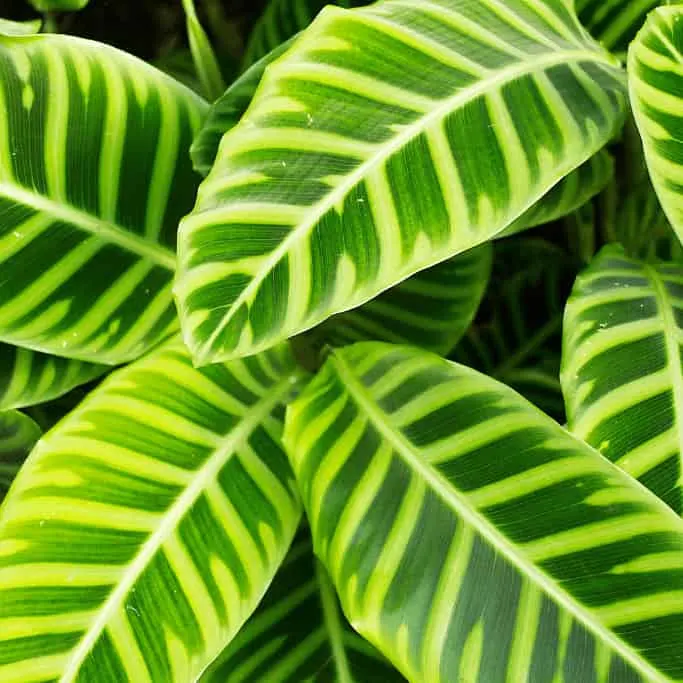
Calathea varieties
The most common Calathea varieties apart from Calathea zebrina are:
- Calathea orbifolia
- Calathea medallion
- Calathea lancifolia (Rattlesnake plant)
- Calathea makoyana (Peacock plant)
- Calathea roseopicta
- Calathea warscewiczii (Jungle Velvet Calathea)
- Calathea rufibarba (Velvet Calathea)
- Calathea ornata (Pinstripe plant)
FAQ
Is Calathea zebrina toxic to cats?
Calathea zebrina is non-toxic to cats and other pets, as stated under the toxic plant database issued by the American Society for the Prevention of Cruelty to Animals. Although the plant is not classified as poisonous to pets, zebra plant saps can irritate some people with sensitive skin or certain allergies.
Is the bathroom a good spot for my Calathea zebrina?
Warm and shaded spots are the best when it comes to placing Calathea, and that’s why they are generally grown in conservatories and greenhouses. But the bathroom is a humid space that makes it just right for placing Calathea zebrina as long as you keep the plant in enough light and moisture.
Can you buy Calathea zebrina at Bunnings?
Bunnings has loads of Calathea zebrinas in size variations that suit your requirements. You can either go for a 5-inch (130mm) zebra plant or a 7-inch one (170mm) if you want to begin with a larger plant.
Where else can you buy Calathea zebrina?
You can buy zebra plants from places that sell tropical foliage plants. You can always purchase them online if you can’t find them around. Amazon and Etsy are two popular options to buy zebra plants from. Simply find a green beauty you like and order them for doorstep delivery.
Can you grow Calathea zebrina outside?
Whether or not a Calathea zebrina will grow outside largely depends on the climatic conditions as it’s a tropical plant. You can grow it outside if the climate around your house is warm and humid, specifically in the USDA plant hardiness zone of 11-12.
The least you need to know About Calathea zebrina Care
Although Calathea zebrina is not a very easy-to-keep houseplant, the kind of beauty that it flaunts makes it all worth it.
However, the plant surely isn’t meant for those who prefer going for a low-maintenance plant.
It’s amazing how a zebra plant can thrive indoors for several years, implying that you can’t place them on small window shelves for long.
But the plant looks undoubtedly gorgeous when it grows tall and when one looks down at them from above.
Just a little careful treatment, and your Calathea zebrina will yield lovely leaves and turn into a glorious houseplant.

Daniel has been a plant enthusiast for over 20 years. He owns hundreds of houseplants and prepares for the chili growing seasons yearly with great anticipation. His favorite plants are plant species in the Araceae family, such as Monstera, Philodendron, and Anthurium. He also loves gardening and is growing hot peppers, tomatoes, and many more vegetables.


